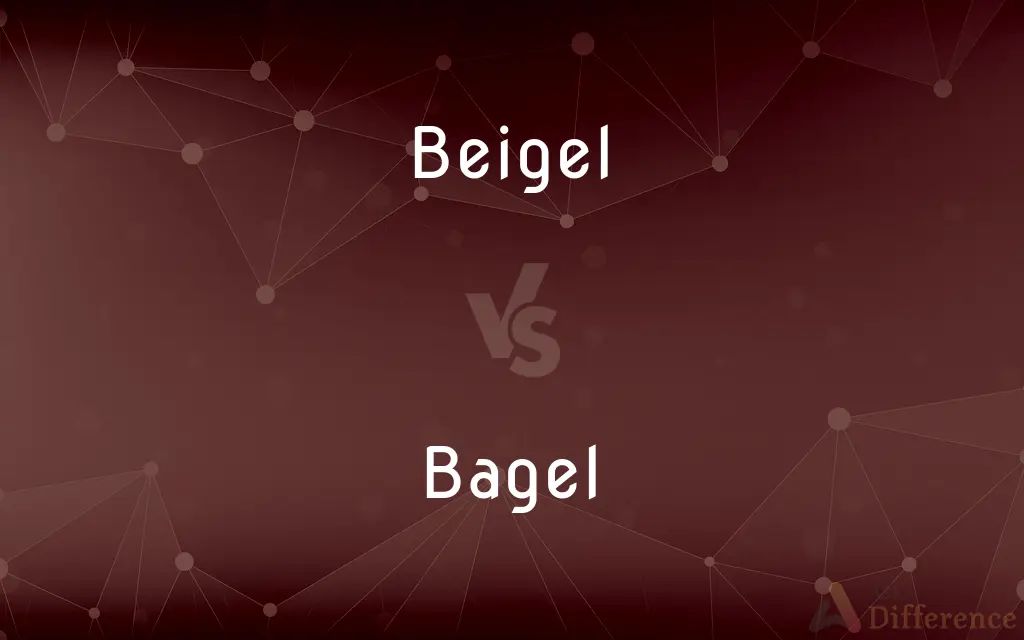Beigel vs. Bagel — What's the Difference?
Edited by Tayyaba Rehman — By Maham Liaqat — Updated on March 31, 2024
Beigel and bagel refer to a bread product famous for its dense, chewy texture and hole-in-the-middle shape, with the primary difference being regional terminology and slight variations in recipe and preparation.

Difference Between Beigel and Bagel
Table of Contents
ADVERTISEMENT
Key Differences
Beigel is the term more commonly used in the United Kingdom, particularly in London's East End, where it denotes a type of bread that is boiled before baking, similar to the bagel. Bagel, more widely known in the United States and Canada, refers to the same type of bread, characterized by its dense texture, chewiness, and the traditional boiling before baking.
While both beigels and bagels are made from yeast dough and are traditionally boiled in water (sometimes with honey, barley malt syrup, or baking soda added) before baking, some argue that there are subtle differences in texture and taste. Beigels are sometimes described as being slightly denser and chewier than their North American counterparts, which can be softer and come in a wider variety of flavors.
The traditional bagel is often associated with Jewish communities in Eastern Europe, and its popularity in North America largely stems from Jewish immigrants. The beigel has a similar history in the UK, with Jewish immigrants introducing the bread to London's East End.
Modern variations of both have diversified in terms of flavors and toppings. In North America, bagels are commonly sliced and served with cream cheese, smoked salmon, or various spreads, and can come in numerous varieties including sesame, poppy seed, cinnamon-raisin, and many more. Beigels, while also enjoying some variety, might lean more towards traditional recipes and flavors in some bakeries, particularly those with a long history or in areas with strong cultural heritage.
Despite these nuances, the terms "beigel" and "bagel" are often used interchangeably outside of their respective regions, and the differences in taste and texture can vary more by bakery than by the specific term used.
ADVERTISEMENT
Comparison Chart
Terminology
Preferred in the UK, especially London.
Common in North America.
Texture
Often described as denser and chewier.
Can be softer and is available in a wider variety of types.
Varieties
Traditional flavors like poppy seed and sesame.
Wide range, including blueberry, cinnamon-raisin, and others.
Serving
Traditionally served with simple fillings.
Often served with cream cheese, smoked salmon, or as sandwiches.
Origin
Introduced by Jewish immigrants in the East End of London.
Became popular in North America through Jewish communities.
Preparation
Boiled before baking, which contributes to its texture.
Similarly boiled before baking, with variations in the boiling liquid.
Compare with Definitions
Beigel
Characterized by its dense and chewy texture.
Beigels from the East End are known for their satisfying chewiness.
Bagel
A boiled-then-baked dense bread, popular in North America.
Bagel shops in New York City offer a wide variety of bagel flavors and toppings.
Beigel
A dense, chewy bread with a hole in the middle, known in the UK.
The beigel shop in Brick Lane is famous for its traditional Jewish recipes.
Bagel
Comes in numerous flavors and can be topped with a wide range of spreads.
From everything bagels to cinnamon-raisin, the variety is endless.
Beigel
Part of Jewish culinary tradition in London.
Beigels have been a staple in London's Jewish community for generations.
Bagel
Reflects broader culinary trends and community tastes.
The popularity of bagel brunches showcases the adaptability of bagels to modern dining trends.
Beigel
Often served with salt beef or simple spreads.
Nothing beats a classic beigel filled with hot salt beef and English mustard.
Bagel
Known for creative adaptations, from flavors to sandwich fillings.
Gourmet bagel shops experiment with ingredients like truffle cream cheese or vegan options.
Beigel
Maintains a traditional approach in preparation and flavor.
Traditional beigel bakeries in London still use recipes passed down through families.
Bagel
Became a part of American cuisine through Eastern European Jewish immigrants.
Bagels are now a staple in American breakfast culture, thanks to their rich immigrant history.
Beigel
(UK) bagel
Bagel
A bagel (Yiddish: בײגל beygl; Polish: bajgiel), also historically spelled beigel, is a bread product originating in the Jewish communities of Poland. It is traditionally shaped by hand into the form of a ring from yeasted wheat dough, roughly hand-sized, that is first boiled for a short time in water and then baked.
Beigel
(Yiddish) glazed yeast-raised doughnut-shaped roll with hard crust
Bagel
A glazed, ring-shaped roll with a tough, chewy texture, made from plain yeast dough that is dropped briefly into nearly boiling water and then baked.
Bagel
A toroidal bread roll that is boiled before it is baked.
Bagel
A score of 6-0 in a set (after the shape of a bagel, which looks like a zero).
Bagel
An overly materialistic and selfish young Jewish man.
Bagel
(tennis) To achieve a score of 6–0 in a tennis set.
Bagel
(sports) To hold an opponent to a score of zero.
Bagel
A glazed leavened doughnut-shaped roll with a hard crust.
Bagel
(Yiddish) glazed yeast-raised doughnut-shaped roll with hard crust
Common Curiosities
Can you find bagels in the UK or beigels in the US?
Yes, both are available in each region, though local terminology and culinary influences may affect their presentation and variety.
Is there a real difference between a beigel and a bagel?
The main difference lies in regional terminology and slight variations in recipe and texture, though both refer to a boiled-then-baked bread.
Why are beigels denser than bagels?
This can depend on the specific recipe and preparation method of the bakery, with some beigels being made to traditional recipes that emphasize a denser texture.
Are beigels or bagels healthier?
The healthiness can vary depending on the ingredients used and the fillings or toppings chosen. Generally, both can be part of a balanced diet.
How should I eat a beigel or bagel?
Both can be enjoyed in numerous ways, from simple with butter or cream cheese to filled with a variety of ingredients like smoked salmon, meats, or even sweet spreads.
Are there sweet versions of beigels?
While traditionally beigels are not sweet, modern variations and toppings can include sweet ingredients, similar to the variety found in bagels.
What's the history behind beigels and bagels?
Both have origins in Jewish communities in Eastern Europe and were brought to the UK and North America by immigrants, becoming staples in their respective culinary landscapes.
What makes bagels soft?
The softness can come from the dough’s hydration level, the boiling process (including what’s added to the boiling water), and baking conditions.
Do beigels and bagels use the same ingredients?
Yes, both are typically made from yeast, flour, water, sugar, salt, and sometimes additional ingredients for flavoring or texture.
Why are beigels boiled before baking?
Boiling before baking gives them their distinctive chewy texture and shiny crust. This is true for both beigels and bagels.
Share Your Discovery

Previous Comparison
Brokerage vs. Commission
Next Comparison
Dress vs. SundressAuthor Spotlight
Written by
Maham LiaqatEdited by
Tayyaba RehmanTayyaba Rehman is a distinguished writer, currently serving as a primary contributor to askdifference.com. As a researcher in semantics and etymology, Tayyaba's passion for the complexity of languages and their distinctions has found a perfect home on the platform. Tayyaba delves into the intricacies of language, distinguishing between commonly confused words and phrases, thereby providing clarity for readers worldwide.














































